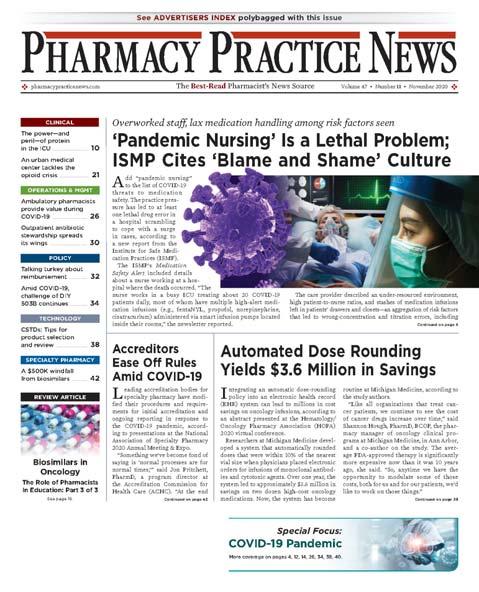
7 minute read
Dashboards drive better medication management
Two new studies have underscored that clinical dashboards can be a powerful medication management tool—in one case during yet another surge in COVID-19 cases.
Tackling TNF Inhibitors
A real-time clinical dashboard to monitor patients taking tumor necrosis factor-alpha (TNF-alpha) inhibitor drugs could save the Durham Veterans Affairs Health Care System at least $302,000 per year and potentially improve medication adherence and patient safety, according to a poster presented at the American College of Clinical Pharmacy 2020 virtual annual meeting.
When the pilot project began in 2019, pharmacists at the health system reviewed patients’ lab values for safety before they were started on these therapies, but pharmacists weren’t necessarily involved in any needed longterm monitoring for safety and adherence, said lead study author Anna Hu, PharmD, BCPS, a drug information specialist with the University of Texas Medical Branch, in Huntsville. She was a PGY-2 pharmacy resident with the Durham VA at the time of the study.
In a quality improvement project conducted between August 2019 and April 2020, in collaboration with other pharmacists and specialty providers in rheumatology, gastroenterology and dermatology, Hu developed a clinical dashboard to capture high-risk patients. Patients with active or recently expired outpatient prescriptions or IV orders for adalimumab, certolizumab (Cimzia, UCB), etanercept, golimumab (Simponi/ Simponi Aria, Janssen) and infliximab were included. Dashboard criteria flagged patients with new infection in the past 30 days, heart failure exacerbation in the past seven days, new malignancy in the past 30 days, use of biologic medications, high treatment doses of etanercept or adalimumab, overdue or critical lab results, emergency department visits in the past 30 days, and inpatient admissions in the most recent 30 days. The dashboard also flagged patients who had overdue refills by more than seven, 14 or 30 days based on the previous fill, or with the last infusion administered more than eight, 10 or 12 weeks ago.
Of 431 patients receiving TNF-alpha inhibitor treatment at the institution, the dashboard flagged 304 circumstances involving 223 unique patients. Among them, 27% of patients had overdue refills, 9% had overdue monitoring labs, 6% had an emergency department visit, 5% had a critical lab result, and 2% were on two biologic agents or had an inpatient admission. Of those with overdue refills, 13% had a refill overdue exceeding 30 days and 6% had their last infliximab infusion more than 12 weeks before.
In addition, Hu and her colleagues found that 17% of patients were on a high dose of inhibitors, with 5% prescribed etanercept 50 mg more often than once weekly, and 12% of patients prescribed adalimumab 40 mg more often than once every other week. These dosages represented an estimated potential annual cost savings of $302,497 if half of the patients were successfully changed to the labeled dosing, Hu said, and this would also reduce patient risk from unnecessary drug exposure.
Patient outcomes could be further improved by working with patients on adherence or refill issues and/or expanding the dashboard to include other highcost specialty medications, she said. Another factor to consider: patients taking these medications are susceptible to infections, so continuation of therapy needs to be reviewed carefully. However, providers did not always document whether continuation of the TNF-alpha inhibitor treatment was appropriate. For these situations, Hu said, pharmacists could assess patient-specific risk factors for infection and recommend to hold, continue or discontinue the treatment. Pharmacists also could play a role in discontinuing duplicate therapy for patients prescribed more than one biologic.
“There is potentially an opportunity to discuss nonadherence with patients and the reasons behind it,” Hu said. “If they have been nonadherent for a long period of time, does that mean they are stable enough to maybe no longer need the medication?” Based on the findings, the VA was planning to implement the dashboard, she said.
Dashboards could be helpful for TNFalpha inhibitors, but it may be beneficial to break patients down further by disease state, commented Erin Hamai Tom, PharmD, a specialty pharmacy supervisor with the University of California, Davis Health System. “There’s a different acuity for GI [gastrointestinal] patients compared to those in rheumatology or dermatology,” Tom said. “For example, it may be more common to have a GI patient on what’s considered a high dose of medication because it’s more frequent that an inflammatory bowel disease patient will require escalation of therapy to reach remission of their disease.”
Pharmacists also can get involved by ensuring all prescreenings recommended in the package insert, for conditions such as tuberculosis and hepatitis B, are completed before therapy is started, Tom added. At her institution, pharmacists use dashboards to monitor patients in the longer term for new malignancies and new or recurring infections. They also do a biannual assessment for efficacy and safety, and monitor for medication adherence and appropriateness of therapy, she said.
Staying in Lane During COVID
Many hospitals experiencing a COVID-19 surge may be overwhelmed by the increase in drug utilization for many agents, including sedatives and vasopressors. In a poster presented at the ASHP 2020 Midyear Clinical Meeting and Exposition, pharmacists from Massachusetts General Hospital (MGH) described a daily dashboard they created to evaluate the use of key agents required for managing COVID-19 patients.
“We have access to so many different sources of data, including ADCs [automated dispensing cabinets] on the floor, carousels in the central pharmacy and IV room workflow systems,” said lead author Blake Barlow, PharmD, MBA, a PGY-2/MS health-system pharmacy administration and leadership resident at MGH. “But a lot of these systems aren’t designed to talk to each other, and many departments of pharmacy have no way to pool all that data together and visualize them at once. When COVID first hit, we were flying blind. We did anticipate that there might be drug shortages, but we did not consider just how large the increase in drug utilization was going to be.”
For example, Barlow said, before the first surge in COVID-19 patients at the end of last March, MGH’s IV hoods might produce 30 1-mg/mL 25-mL bags of hydromorphone daily. “That’s our average use throughout the hospital, but during COVID, that increased 500% to 1,000%.” (In mid-April, at the hospital’s COVID-19 peak, more than 350 bags per day were made.) “We had to scramble to make a lot of the new medications that our typical batch schedule could no longer handle, so we needed to figure out a way to collect electronic health record data on medication use, along with data from the ADCs in all the COVID ICUs and the COVID non-ICU settings, as well as our central pharmacy storage carousel, and pool it all in a central database that could be visualized via a dashboard,” Barlow said.
Based on previous information technology projects he undertook during residency, Barlow was already familiar with the systems from which reporting was required, so the initial build of the database and dashboard took only a day. “Every time we ran it, we still needed to do about 15 to 20 minutes of manual manipulation and validation to be sure the data we were presenting to departmental and hospital leadership was correct,” he said. “But then we were able to send this information out daily to leaders in pharmacy operations, clinical pharmacy and supply chain. It allowed us to implement multiple different medication distribution shifts throughout the day for COVID-specific medications, and to predict how many medications we would need to start making ahead of time in the IV room every day.”
For more cost-saving interventions, see page 1; for more on MGH’s COVID-19 response, see page 14. —Karen Blum and Gina Shaw
Figure. Daily usage of selected COVID-specific medications at Massachusetts General Hospital.
Hydromorphone (orange line), norepinephrine (gray line), and dexmedetomidine (blue line) represent internally made products that required dynamic changes in a previous, predefined batch compounding schedule. Propofol (yellow line) represents a commercially prepared product that required rapid changes to medication distribution strategies.
Like What You Read in Pharmacy Practice News?













